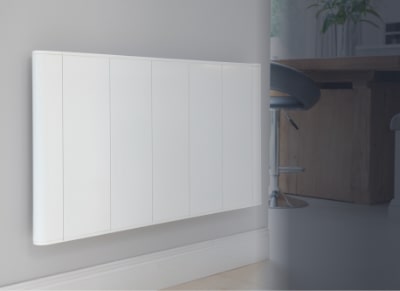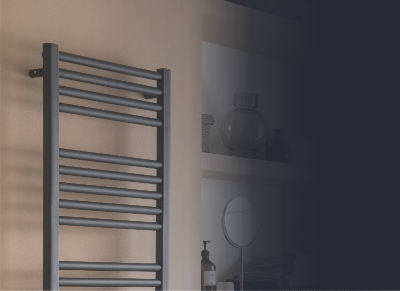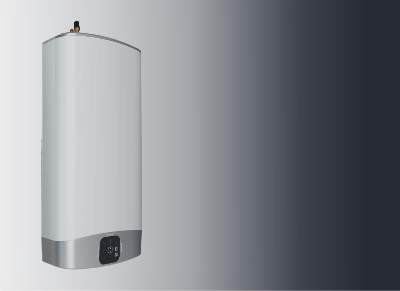Replacing
Storage Heaters
From moving into an older property, to never having the time to upgrade or simply owning a house with outdated heating, there are a variety of different reasons why your home might have storage heaters as your primary source of warmth.

Originating from post-World War Two, the use of storage heaters in properties across the UK has long since become outdated and expensive to run compared to alternative heating methods. If you’re looking to increase the efficiency, effectiveness and control of the heat in your property, then replacing your electric storage heaters might be the right choice for you.
The rest of your property is likely modernised to meet the contemporary requirements of a family or household, so why not your heating?
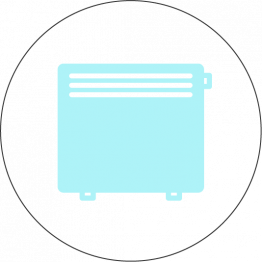
How do storage heaters work?
Designed for people who are on time-of-use type electricity tariffs, which can include Economy 7 or Economy 10, these electrically powered heaters function differently to modern electric radiators for heating.
However, an inflated day rate on many of these tariffs means the money you save overnight doesn’t account for the inflated day rate; leaving people out of pocket over time for their heating.
Storing thermal energy using ceramic bricks overnight, in order to heat a property during the day, these units require forward planning and can often result in a property being too warm in the morning when the most heat is stored, and then too cool in the evening when you need the heat the most.

Why replace your storage heaters
There are a variety of different reasons you may want to look at replacing storage heaters with electric radiators within your property. From a lack of flexibility in the colder months, to the need to replace or update your heating system to something more efficient, there are many different situations in which you might consider a replacement.
Not enough heat when you need it
For working families or professionals, heating a property that you’re not currently inhabiting just isn’t cost effective or energy efficient, especially in older homes where much of that heat is lost by the evening. Over time, the convected heat will also rise, leaving properties cool at the bottom with much of the heat escaping through the walls and roof.
Manual functionality
How do storage heaters know when to come on? In many of the basic models, the functionality to ‘know’ when heat is required is missing. For many properties with storage heaters, the models are often older and manual, relying on the homeowner’s memory and knowledge of the next day’s weather to plan accordingly.
As well as the manual requirements for maintaining heat with a night storage heaters system, models dating back to the 70’s can even pose a health risk to dwellers – as they may contain Asbestos as a method of fire prevention. In these cases, it’s important to inform your local council before you make any plans for replacing your overnight storage heaters.
Time to upgrade
Although storage heater replacements are available on the market, the up-front purchase cost for a storage heater is expensive, including the price of removal and installation. In this case, considering alternatives to conventional Economy 7 heaters and opting for a more modern solution may be the ideal fit.
Not only are storage heaters often difficult to replace with a similar equivalent, you will be lumbered with installation the of two heavy pieces of equipment each time an upgrade is required, making storage heaters or storage radiators difficult to handle and hugely inconvenient.
Electric radiators as an alternative to storage heaters
If you’re considering removing electric storage radiators or heaters from your property and replacing them with a more efficient, viable and effective solution, then choosing to replace storage heaters with electric radiators might be the right choice for you.
In comparison to the larger and less effective economic heaters that storage heaters claim to be, electric radiators are sleek and simple in design, with all the modern features required to make them the perfect choice for any household.
More flexibility
Electric radiators are more modern in design, and as such are far more compact and flexible when it comes to size and style. Not only does this enable more precious space in smaller rooms, it also allows radiators to fit in locations where a storage heater would be impossible to locate.
With this increase in style, there’s also an increase in functionality, offering more flexibility on how you manage your heating on a day to day basis. There’s no need to keep an eye on the weather forecast or upcoming temperatures – with electric radiators, you will have the freedom to heat rooms only when and where you need it, even if your schedule varies throughout the week.
Increased control
Whereas storage heaters might provide consistent, everyday heat that is generated overnight, opting for a modern electric radiator provides the control that a modern household needs to manage their heating efficiently and effectively. This control includes access to a precise thermostat to match the exact temperature you want, as well as the ability to better ‘zone’ the colder areas of the home to reduce heat wastage.
Modern electric radiators work via advanced heating elements within the unit that allow for fast and efficient heating that a storage heater just can’t compete with.
Some of the most contemporary electric radiators even feature compatibility with apps and other home systems, allowing them to be fully integrated into existing control systems.
Better value for money
Storage heaters may have been originally designed for those using an Economy 7 tariff, but for many, the daytime cost leaves the overnight value hardly worth it. Electric radiators don’t require that overnight usage, and as such, there’s no need to pay more for a system you’re not using.
Economically, switching to electric radiators makes a lot of sense. In addition to lower running costs, the increased efficiency of electric radiators results in less electricity needed to keep a room consistently heated. Combine that with the better value cost of an electric heater, with all the functionality of an expensive automatic storage heater model and more, and you’ll soon be saving money on the cost of heating your home.
Superior safety
The excessive external temperature of a storage heater can run the risk of causing damage to the immediate environment. In fact, storage heaters have a history of safety concerns, including many 1970s models which often included asbestos which could potentially cause harm. In comparison, an electric radiator ticks all the boxes for safety, making them a better fit for busy households and families who don’t need the added stress of worrying about their heating unit.
“Enclosed, economical and efficient. Electric radiators have it all.”
Warmer faster
Unlike storage heaters, which require a set amount of time to produce the heating capacity required for a day, electric radiators work very similarly to central heating radiators. They can warm up on cue, and the warmer air can then continue to circulate around the room to produce the desired heat. This not only maintains a good average temperature but also replenishes heat as it is lost.
Combine that quick warmth with the versatility of a radiator that requires no plumbing and is very simple to install, you have a source of heating that can maintain your home at a comfortable temperature when you need it, with no wasted energy or electricity when you are out of the house.
Making the change: how do you replace storage heaters?
If the idea of switching to electric radiators from your old storage heaters sounds like the perfect solution for heating your house, you’re not alone. Many people are making the change from the old, cumbersome and slow heating system to a more modern, effective approach. If electric radiators sound like the right choice for you, follow these steps to make the change.
1. Switch to standard
Many households who use storage heaters do so because they are on Economy 7 tariffs, which often have an oversize day cost for the use of power. If you’re looking to switch those storage heaters off permanently, then start by switching to a better value, more competitive standard energy tariff. This tariff will cost the same no matter what time you’re using your electricity, ensuring that you are saving costs during the day and still keeping each room at at the optimum temperature.
2. Shop around
When choosing the best energy tariff for your home, sticking with the same company isn’t always your best bet. We recommend spending some time researching the energy market to figure out the best costs for your home and get that new tariff set up in preparation for the removal of those space-wasting storage heaters to make way for your shiny new electric radiators!
3. Choose your radiators
Not all radiators are built equal, but there are different models to match your every requirement. Take a look at what your precise needs are when it comes to heating your home, whether it’s heating a single room for just a few hours in the evening or helping you to save energy and money by heating specific rooms only.
The size and power of your radiator may also depend on how big the room you want to heat is, and for particularly large rooms more than one radiator may be necessary – as with conventional central heating.
Of course, it’s just as important – and much more exciting – to pick a sleek, shiny new radiator that matches the style of your property, so make sure you take interior design into consideration as well in order to get something that blends perfectly with your decor.
Modern and attractive, electric radiators don’t just work better – they look better too!
4. Remove old storage heaters
Removing a storage heater isn’t a DIY job – and it’s definitely something you’ll want to bring the professionals in for. Often, if you’ve got your new radiators ready and waiting, an electrician will be able to get them wired in at the same time; leaving you ready and raring to go. As storage heaters are hardwired into the wall, an electrician will be able to provide a service for removing storage heaters directly from the mains and remove it within a couple of hours per heater.
The average storage heater is wired into both off- and on-peak electricity, allowing an energy supplier to calculate the cost of your electricity accurately, especially on an Economy 7 tariff.
Though quotes for electricians will vary, a full house of storage heaters could cost between £500 and £1000, without any complications.
Your electrician might offer to dispose of the units for you or provide this as part of the service, but otherwise, a skip or visit to the tip might be required. Bear in mind that storage heaters aren’t light – after all, they are full of bricks – so if you have the option for them to be taken away after removal, it might be the best choice. Otherwise, you may be left with multiple units weighing up to 400kg(!) and no way to dispose of them.
Prior to booking an electrician, ensure that your model of storage heater doesn’t contain asbestos, especially if it was installed in the 70’s. You can see a list of models with asbestos on the Asbestos Information Centre website here.
5. Install and programme new radiators
If you’re already having storage heaters removed by an electrician, it’s likely they can install your new electric radiators for you as part of the same job, leaving you with the significantly easier and more exciting job of programming and setting up your new heating system.
The exact setup requirements will vary from model to model, but this may including setting a thermostat, installing and updating a smart system on a phone or tablet or simply setting a timer for when you want the radiator to produce heat.
Refer to the instructions provided with your units for the exact needs, and enjoy your new, energy efficient heating system.
Looking to make the change?
If you’re looking for great quality and efficient electric radiators for storage heater replacement, we have something to suit any household. See our full product range below, or get in touch with one of our sales representatives on 01423 733 000 to chat about the best mix of electric heaters for your home.
